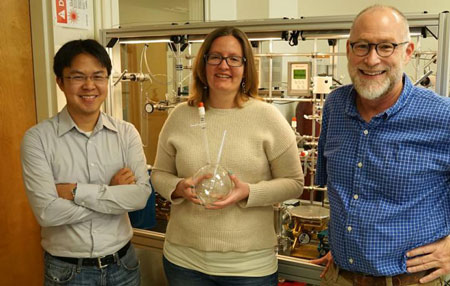| May 11, 2015 |
Photosynthesis has unique isotopic signature
|
|
(Nanowerk News) Photosynthesis leaves behind a unique calling card in the form of a chemical signature that is spelled out with stable oxygen isotopes, UCLA geochemists reported April 24 in the journal Science ("Biological signatures in clumped isotopes of O2"). The findings suggest that similar isotopic signatures could exist for many biological processes, including some that are difficult to observe with current tools.
|
|
The isotopic signature could be used, for example, to assess the health of oceans, said lead author Laurence Yeung, formerly a UCLA postdoctoral scholar in the laboratory of Edward Young, UCLA professor of geochemistry and cosmochemistry in the department of earth, space and planetary sciences. Photosynthesis by microscopic plants forms the base of the oceanic food chain, but it is difficult to measure how productive these plants are in natural settings. This research will make it easier to do so.
|
 |
| Laurence Yeung, Jeanine Ash, Edward Young
|
|
"We've found a new type of biosignature," said Yeung, now an assistant professor of Earth science at Rice University. "We show that plants and plankton impart this type of biosignature on the oxygen they produce during photosynthesis."
|
|
Most oxygen atoms contain eight protons and eight neutrons and are represented by the symbol O-16. More than 99.9 percent of Earth's oxygen is O-16, but two heavier oxygen isotopes exist in trace amounts: O-17, with one extra neutron, and O-18, with two.
|
|
Scientists know that plants and animals sometimes process heavy isotopes like O-17 and O-18 at a different pace than O-16. For instance, when sea temperatures decrease, corals and mollusks produce calcium carbonate -- the raw material of ocean reefs and clam shells -- that contains greater amounts of heavy oxygen isotopes. As a result, scientists have used isotopic ratios from carbonate fossils to estimate global temperatures in the distant past.
|
|
In the new study, the researchers examined "clumped" oxygen isotopes, oxygen molecules that contain two heavy isotopes. Such molecules, which have masses of 35 or 36, are exceptionally rare; less than a handful exist in every trillion oxygen molecules. Today's mass spectrometers, however, are sophisticated enough to tally them and allow scientists the opportunity to compare their relative abundance in various circumstances.
|
|
The new research shows that biological assembly of molecules produces molecules that have pairings of isotopes that violate expectations from both thermodynamics and sheer chance.
|
|
Young, the study's senior author, said the new research elucidates a general principle that may apply to a wide range of processes in nature.
|
|
"This study introduces an entirely new way of determining how oxygen specifically, and other gases more generally, are produced in nature," Young said. "Our work demonstrates that the propensity of different isotopes to bond with one another in a molecule is a heretofore unrecognized, yet powerful tracer of the biological origin of that molecule."
|
|
Looking at oxygen through the lens of clumped isotopes will provide a great deal of new information about how oxygen is made and consumed by plants, said co-lead author Jeanine Ash, a UCLA graduate student in Young's laboratory.
|
|
"There are so many other gases that the biosphere utilizes," she said. "This is only the beginning."
|

